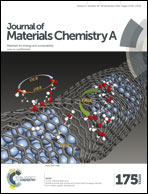An electron-rich 2-alkylthieno[3,4-b]thiophene building block with excellent electronic and morphological tunability for high-performance small-molecule solar cells†
Abstract
Bulk-heterojunction organic solar cells have been attracting much attention because of the potential for producing low-cost, large-area, and flexible PV panels. Generally, the ideal donor materials should have an appropriate electronic structure to absorb more sunlight and drive charge separation and to form an optimized morphology that can efficiently split excitons and collect charges. 2-Alkylthieno[3,4-b]thiophene (T34bT) as an electron-rich moiety possesses three features that are highly desirable for donor materials: (i) to modulate electronic structure; (ii) to manipulate the blend morphology of the active layer; (iii) to function as the π-bridge to link donor and acceptor moieties. We report herein a new category of small molecules STB-n based on the electron-rich T34bT moiety. STB-n featuring T34bT and rhodanine components showed intense absorption, reduced bandgap, and proper alignment of frontier orbital energy levels. Because of the optimized charge-transport properties and weak charge recombination, STB-3-based solar cells exhibit a power conversion efficiency of 9.26%, which is among the best reported for small-molecule-based solar cells. The relationships among molecular structure, thin-film morphology, and device performance were further investigated systematically.
![Graphical abstract: An electron-rich 2-alkylthieno[3,4-b]thiophene building block with excellent electronic and morphological tunability for high-performance small-molecule solar cells](/en/Image/Get?imageInfo.ImageType=GA&imageInfo.ImageIdentifier.ManuscriptID=C6TA08790F&imageInfo.ImageIdentifier.Year=2016)

 Please wait while we load your content...
Please wait while we load your content...